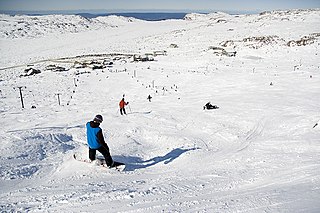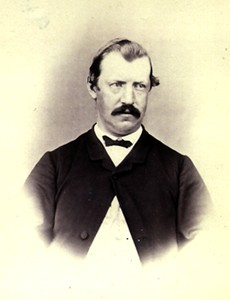| Giblin Peak | |
|---|---|
Location in Tasmania | |
| Highest point | |
| Elevation | 1,569 m (5,148 ft) [1] [2] |
| Prominence | 9 m (30 ft) [2] |
| Isolation | 0.34 km (0.21 mi) [2] |
| Listing | 3rd highest mountain in Tasmania [2] |
| Coordinates | 41°31′48″S147°39′00″E / 41.53000°S 147.65000°E Coordinates: 41°31′48″S147°39′00″E / 41.53000°S 147.65000°E [3] |
| Geography | |
| Location | Northeast Tasmania, Australia |
| Parent range | Ben Lomond |
The Giblin Peak is a mountain of the Ben Lomond mountain range in northeast Tasmania, Australia. [4] It is the highest elevation on Giblin Fells, a prominent bluff south of Ben Lomond's highest elevation - Legges Tor.

A mountain is a large landform that rises above the surrounding land in a limited area, usually in the form of a peak. A mountain is generally steeper than a hill. Mountains are formed through tectonic forces or volcanism. These forces can locally raise the surface of the earth. Mountains erode slowly through the action of rivers, weather conditions, and glaciers. A few mountains are isolated summits, but most occur in huge mountain ranges.

Ben Lomond is a mountain in the north-east of Tasmania, Australia.

A mountain range or hill range is a series of mountains or hills ranged in a line and connected by high ground. A mountain system or mountain belt is a group of mountain ranges with similarity in form, structure, and alignment that have arisen from the same cause, usually an orogeny. Mountain ranges are formed by a variety of geological processes, but most of the significant ones on Earth are the result of plate tectonics. Mountain ranges are also found on many planetary mass objects in the Solar System and are likely a feature of most terrestrial planets.
Contents
With an elevation of 1,569 metres (5,148 ft) above sea level, it is the third highest mountain in Tasmania [2] and named after William Giblin, a previous Premier of Tasmania. [5] [6] [7] [8]
The Australian Height Datum is a vertical datum in Australia. According to Geoscience Australia, "In 1971 the mean sea level for 1966-1968 was assigned the value of 0.000m on the Australian Height Datum at thirty tide gauges around the coast of the Australian continent. The resulting datum surface, with minor modifications in two metropolitan areas, has been termed the Australian Height Datum (AHD) and was adopted by the National Mapping Council as the datum to which all vertical control for mapping is to be referred."

William Robert Giblin was Premier of Tasmania (Australia) from 5 March 1878 until 20 December 1878 and from 1879 until 1884.
Before the northern aspect of the Ben Lomond plateau was surveyed, Stacks Bluff (at the plateau's southern extremity) was thought to be the highest elevation on the Ben Lomond plateau. From 1905 to 1912 a full survey of Ben Lomond was conducted by Colonel W.V. Legge and his survey party. The survey party explored the highlands on the north of the plateau in 1907. Legge had long suspected that the north of the plateau was higher than the trigonometric station on Stacks Bluff although it is less obviously elevated from casual observation. Moreover, the area was, at the time, an area so remote and unexplored that Legge described it as 'untrodden as the distant ranges of the west coast'. [7] Lyndhurst Giblin, a member of Legge's survey party, climbed and measured the true summit and named it after Legge and, in turn, the prominent bluff to the south of the summit was named for Giblin's father - Giblin Fells. [7] [8]

The Stacks Bluff is a peak in northeast Tasmania, Australia. The mountain is situated on the Ben Lomond plateau.

Colonel William Vincent Legge was an Australian soldier and an ornithologist who documented the birds of Sri Lanka. Legge's hawk-eagle is named after him as is Legges Tor, the second highest peak in Tasmania.
Lyndhurst Falkiner Giblin DSO MC was an Australian statistician and economist. He was an unsuccessful gold prospector, played rugby union for England, and fought in the First World War.










